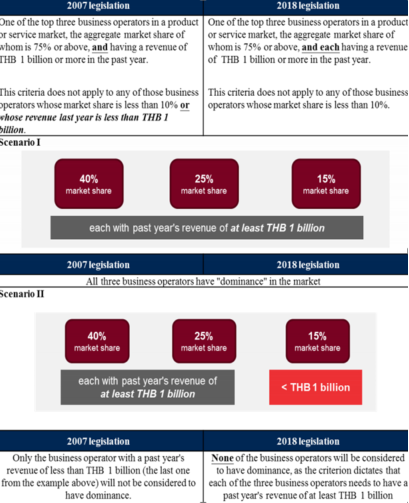23 April, 2019
The criteria for defining dominance under the 2017 Trade Competition Act materially follow the criteria under the 1999 Act. Nonetheless, how the criteria for determining whether a business operator has "dominance" is currently worded can leave some wondering, particularly the criteria for determining the top three business operators with dominance in a given market. Compared to its 2007 predecessor, the 2018 subordinated legislation dominance seems to be open for a different interpretation.
Let's take a look at how the two drafts are different, and how each can be interpreted.
Please click on the table to enlarge.
Although the current drafting of the dominance criteria yields a result different from that of its predecessor, the drafting intention appears to be only to let off the hook the business operator having less than THB 1 billion revenue in the previous year. It is expected that this wording will be officially revised so that the criteria have the same effect as they did before.
The interpretation of the criteria on dominance will be crucial since business operators with a "dominant position" are imposed more stringent compliance obligations. Any business operator having dominance is prohibited from:
(a) unfairly determining or fixing price;
(b) unfairly setting conditions such that their trade partners would have to restrict their services, production, purchase, or sale, or limit their opportunities in purchasing products or services or in seeking credit from other business operators;
(c) ceasing, restricting, or reducing services, production, purchase, sale, delivery, or importation into Thailand without due reasons, as well as destroying or damaging goods with the purpose of causing excess demand for such goods; or
(d) interfering business operation of other business operators without reasonable ground.
For further information, please contact:






